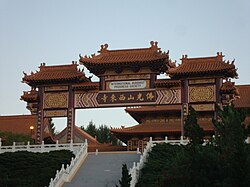Hsi Lai Temple
| Hsi Lai Temple | |
|---|---|

The mountain gate of Hsi Lai Temple
|
|
| Basic information | |
| Location | 3456 South Glenmark Drive, Hacienda Heights, CA 91745 |
| Geographic coordinates | 33°58′33″N 117°58′04″W / 33.9757°N 117.9679°WCoordinates: 33°58′33″N 117°58′04″W / 33.9757°N 117.9679°W |
| Affiliation | Humanistic Buddhism |
| Country | United States |
| Website | www |
| Architectural description | |
| Founder | Hsing Yun |
| Completed | 1988 |
| Hsi Lai Temple | |||||||
| Traditional Chinese | 佛光山西來寺 | ||||||
|---|---|---|---|---|---|---|---|
|
|||||||
| Transcriptions | |
|---|---|
| Southern Min | |
| Hokkien POJ | Hu̍t-kong-san-sai-lâi-sī |
Fo Guang Shan Hsi Lai Temple (Chinese: 佛光山西來寺; pinyin: Fóguāngshān Xīlái Sì) is a mountain monastery in the northern Puente Hills, Hacienda Heights, Los Angeles County, California. Completed in 1988, it is one of the largest Buddhist temples in the Western Hemisphere. The name "Hsi Lai" means Coming West.
Hsi Lai Temple is affiliated with Fo Guang Shan, a Buddhist organization from Taiwan. It is the order's first overseas branch temple, and serves as the North American regional headquarters for Fo Guang Shan. Hsi Lai Temple was the site of the founding of Buddha's Light International Association, established in 1991. The temple, like its mother temple in Taiwan, practices Humanistic Buddhism.
In 1976, Master Hsing Yun, the founder of the order, represented a Buddhist group from Taiwan to participate in America's bicentennial celebration. Master Hsing Yun was asked by American friends to build a monastery in the United States. Therefore, Fo Guang Shan asked the Venerable Tzu Chuang (who, upon the inception of the temple, became the founding and first abbess of Hsi Lai Temple) and Yi Heng to plan and organize the construction of the temple in the Greater Los Angeles area. It was officially registered under the name of International Buddhist Progress Society. Until the temple was complete, Ven. Tzu Chuang bought an old church building, which was to be Hsi Lai's temporary headquarters. The original temple, located in the city of Maywood was called the Bai Ta (White Pagoda) Temple.
The planning and construction of the temple in the 1980s was met with suspicion and resistance from local communities, many of whom knew little about Buddhism and had unfounded fears of Buddhist practices. Many felt that the project was too big for a neighborhood of single-family home and that the traditional Chinese architectural style would not fit in. The main reasons for resistance against the building of the temple were the impact of weekly services, heavy traffic, noise, and concern about environmental damage.
...
Wikipedia
